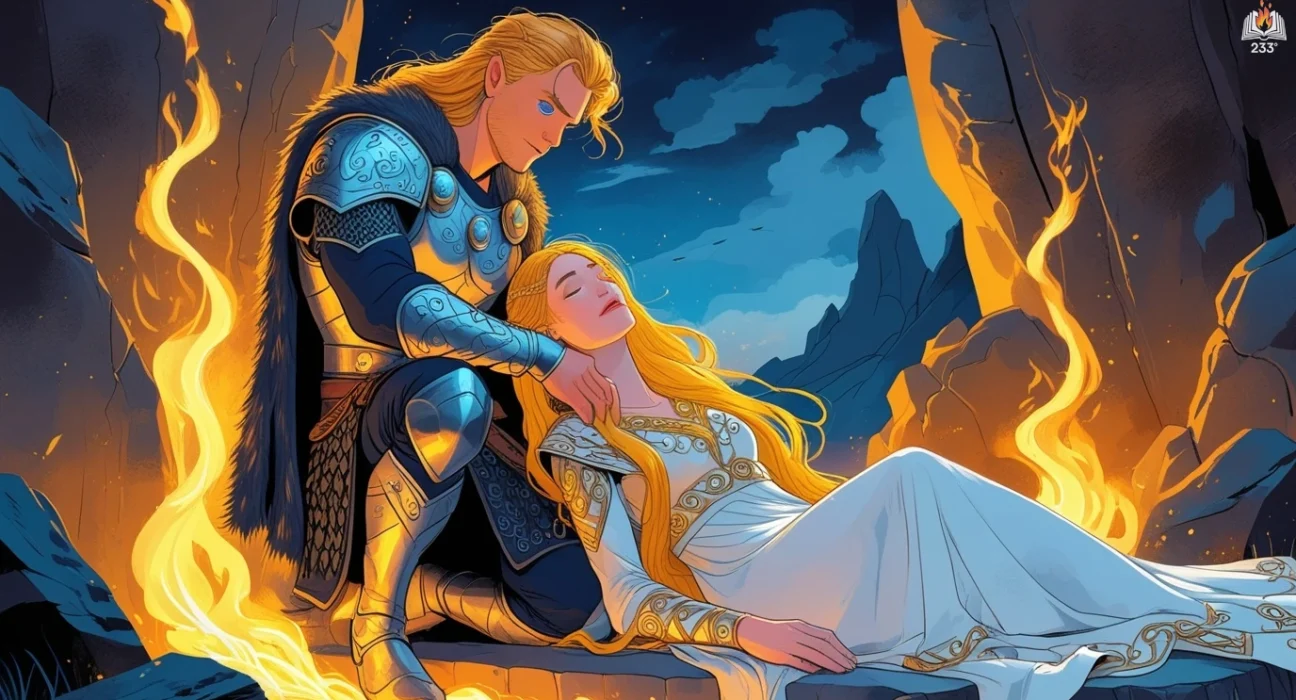The Legend of Sigurd & Gudrún by J.R.R. Tolkien, published posthumously in 2009, is a poetic retelling of the Norse sagas associated with the Volsung legend and the myth of Sigurd the dragon-slayer. Written in alliterative verse, the work reflects Tolkien’s deep immersion in Old Norse literature, mythology, and philology. The text comprises two major lays: The Lay of the Völsungs, recounting Sigurd’s heroic exploits, and The Lay of Gudrún, which explores the tragic aftermath of betrayal, vengeance, and doomed love. This book captures Tolkien’s scholarly expertise and his creative flair, weaving ancient mythic themes into a cohesive, poetic narrative.
Plot Summary
In a world shaped by gods and haunted by curses, the Volsungs rose, bound to a destiny both glorious and tragic. Born of Sigmund and Hjordis, Sigurd carried within him the fire of heroes and the shadow of doom. Aided by the cunning smith Regin, he grew into a figure of unmatched strength and courage, wielding the reforged blade Gram—a sword of legend and prophecy. The call of his fate led him to a deadly encounter with Fafnir, a dragon whose hoard of gold carried a curse darker than the creature itself.
Sigurd, unflinching, plunged Gram into Fafnir’s heart, vanquishing the beast and bathing in its blood. This act rendered him nearly invulnerable, save for a single spot where a leaf had shielded his flesh. With the dragon’s gold in his grasp, Sigurd unknowingly inherited its curse, a shadow that would trail him to the end. Among the spoils was a magical ring, steeped in ruin and treachery, its power laced with the promise of despair.
In the wake of his triumph, Sigurd ventured to the heights of Hindarfell, where he discovered Brynhild, a Valkyrie condemned to mortal sleep by Odin’s decree. Awakened by his courage, she kindled in Sigurd both love and awe. The two swore their devotion, bound by a passion as fierce as the fire that once encircled her resting place. Yet the threads of fate are rarely gentle, and Sigurd’s path soon led him to the court of the Nibelungs.
At the Nibelung court, Sigurd became entangled in a web of loyalty, ambition, and betrayal. Bound by oaths to Gunnar, the Nibelung king, Sigurd used deception and sorcery to help Gunnar claim Brynhild as his bride. Disguised as Gunnar, Sigurd crossed the wall of fire protecting her, winning her hand but fracturing her trust. Brynhild, unaware of the trickery at first, married Gunnar, her fiery spirit smoldering with hidden resentment.
When the truth of Sigurd’s role in her betrayal came to light, Brynhild’s grief and fury erupted. Her love for Sigurd turned to vengeance, and she sowed discord among the Nibelungs. Consumed by the curse of the treasure and the weight of broken promises, Gunnar and his brother Högni conspired against Sigurd. In a brutal ambush, Sigurd fell, pierced by treachery, his lifeblood mingling with the curse that had marked him since Fafnir’s death. His final moments were filled with sorrow for Brynhild and the tragedy that their love had become.
Brynhild, stricken by guilt and despair, ended her own life, seeking to follow Sigurd into the shadowed realms beyond. Her body was laid beside his, the flames of her pyre illuminating the darkness that had engulfed the Nibelung clan. Yet even in death, the curse lingered, feeding on the sorrow and greed that remained.
Gudrún, sister to Gunnar and widow of Sigurd, bore the weight of grief and vengeance. Her fate intertwined with that of Atli, a king whose ambition rivaled the gods. Drawn into marriage with Atli, Gudrún became a pawn in his schemes to claim the cursed treasure of the Nibelungs. Atli, driven by greed, betrayed the Nibelungs, luring Gunnar and Högni to his hall under false pretenses. There, the brothers were captured, their defiance met with cruelty.
Atli demanded the location of the treasure, but the Nibelung spirit could not be broken. Högni, loyal to his brother and their shared honor, faced a grim death, his heart cut from his living body. Gunnar, unyielding, was cast into a pit of serpents, where he perished, singing a defiant song that echoed through the hall. The treasure’s secret was lost, swallowed by the Rhine, its cursed gleam extinguished beneath the waves.
Gudrún, scarred by the loss of her kin and consumed by vengeance, turned her fury upon Atli. In a final act of defiance, she took his life, extinguishing the flame of his ambition. Yet the price of vengeance was her own sorrow, a burden she bore as she wandered the earth. The cursed treasure, now buried in the river’s depths, remained a silent testament to the ruin it had wrought.
As the rivers flowed and the stars turned in the heavens, the songs of Sigurd and the Nibelungs endured. Their tale, steeped in the fire of gods and the tears of mortals, became a hymn to the power of fate and the weight of human choices. The world moved on, yet the echoes of their deeds lingered, whispering of glory and tragedy to all who dared to listen.
Main Characters
Sigurd: The central hero of the story, Sigurd is a dragon-slayer, famed for his strength, courage, and tragic destiny. He gains the treasure of Fafnir but is ensnared in a web of betrayal and vengeance that ultimately leads to his demise. His heroic deeds and doomed love with Brynhild make him a quintessential epic figure.
Brynhild: A Valkyrie and Sigurd’s love, Brynhild is proud, fiery, and deeply bound to honor. Betrayal by Sigurd and his subsequent marriage to Gudrún fuel her desire for vengeance, culminating in the tragic events of the narrative.
Gudrún: Sister of Gunnar and wife of Sigurd, Gudrún is a pivotal figure caught in the cycle of vengeance. Her grief over Sigurd’s death and her later role in the destruction of her kin highlight her as both a victim and an agent of the narrative’s tragic trajectory.
Gunnar: Gudrún’s brother and a king of the Nibelungs, Gunnar plays a crucial role in the betrayal of Sigurd. Despite his loyalty to kinship and honor, he is manipulated into actions that drive the saga toward its tragic conclusion.
Atli: A character based on Attila the Hun, Atli is Gudrún’s second husband. His greed and ambition drive the conflict with the Nibelungs, culminating in the brutal destruction of his household at Gudrún’s hands.
Fafnir: A dragon guarding a cursed hoard of gold, Fafnir’s slaying by Sigurd is one of the most iconic moments in the legend. The treasure he guards becomes both a symbol of power and a curse, bringing ruin to all who possess it.
Theme
Heroism and Fate: The lays explore the Norse ideal of heroism, emphasizing courage, honor, and the inevitability of fate. Sigurd’s tragic arc demonstrates the inevitability of his doom despite his extraordinary prowess.
Betrayal and Vengeance: Betrayal is a central motif, as seen in the treachery against Sigurd by Gunnar and Brynhild’s wrath. Vengeance drives much of the action, showcasing the destructive cycle of retribution that defines the saga.
Love and Loss: The doomed love between Sigurd and Brynhild, as well as Gudrún’s grief, underscores the emotional weight of the narrative. Love is portrayed as both a source of strength and a cause of tragedy.
The Curse of Wealth: Fafnir’s hoard, cursed by its origins, symbolizes greed and its consequences. Those who seek the treasure are inevitably consumed by it, reflecting a deep suspicion of wealth and power in Norse mythology.
Mythic Cycles and Renewal: The narrative aligns with Norse cosmology, particularly the idea of Ragnarök—the death and rebirth of the world. The cyclical nature of destruction and renewal mirrors the fates of the characters.
Writing Style and Tone
Tolkien adopts the alliterative verse form characteristic of Old Norse and Anglo-Saxon poetry, weaving his words with rhythm and sound that evoke the epic grandeur of the source material. His meticulous attention to the structure of verse—marked by heavy stresses, alliteration, and vivid imagery—captures the archaic beauty of the myths.
The language is both formal and lyrical, filled with kennings (metaphoric phrases like “whale-road” for the sea) and stark descriptions of violence and heroism. Tolkien’s use of mythic symbolism and archetypes imbues the text with depth, echoing the sagas that inspired him while also infusing them with his creative vision.
The tone is somber and elegiac, reflecting the tragic nature of the Norse sagas. Moments of grandeur and heroism are shadowed by the inevitability of loss and death, creating an atmosphere of profound melancholy and awe. Tolkien’s scholarly precision ensures fidelity to the spirit of the original sagas while his poetic talent enhances their emotional and narrative power.
We hope this summary has sparked your interest and would appreciate you following Celsius 233 on social media:
There’s a treasure trove of other fascinating book summaries waiting for you. Check out our collection of stories that inspire, thrill, and provoke thought, just like this one by checking out the Book Shelf or the Library
Remember, while our summaries capture the essence, they can never replace the full experience of reading the book. If this summary intrigued you, consider diving into the complete story – buy the book and immerse yourself in the author’s original work.
If you want to request a book summary, click here.
When Saurabh is not working/watching football/reading books/traveling, you can reach him via Twitter/X, LinkedIn, or Threads
Restart reading!








